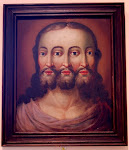Never Been Known To Fail
Growing up, I have to say that my mental image of the Church has always been defined by the 'landscape' in which I lived. It was, for me, experienced primarily through a series of images: women in veils, Sacred Heart scapulars, walking on one's knees, sampaguita-clad statues of the saints, golden retablos, and the graphic depiction of the sufferings of the Crucified. These for me served as a background of sorts, a tapestry on which I somehow based my idea of what the Church was. One of the most ubiquitous components of that tapestry is the novena to St. Jude.
I'm sure you've seen them everywhere. They are usually hidden in some back pew of a grand church, photocopied or printed individually. I've collected a lot of these 'pamphlets' over the years; when I was a student in the sixth grade, I recall plundering our parish for copies of the novena, intrigued by its audacious claim of 'it has never been known to fail'. In 2002, I had the chance to visit Mission San Juan Capistrano in California; St. Jude was there, too, only it was a pamphlet-slash-booklet, containing nine copies of the prayer within. When I started college, I began to collect more and more of these novenas. They range in size from A4 bifolds to 3in by 3in laminated squares small enough to fit in your wallet.
I've never prayed the novena, though. Despite always being intrigued by it, I guess I was never desperate enough to give it a try. But with the worsening economic crisis and other factors, there seems to be an influx in the saint's devotees. I think it's quite fitting (and bitingly ironic) that the shrine of St. Jude in Manila is proximate to Malacanang Palace, the seat of the national government.
Perhaps one reason why I'm so reluctant to give the St. Jude novena a try is because it always seemed like folk magic to me. I have blogged before about the somewhat neurotic religious environment in which I grew up, where evangelical Protestantism seemed to mesh with traditional Roman Catholic piety. While I learned to cross myself, say the Our Father and the Hail Mary, I was also being told about the end of the world, the rapture, and all of that. I took this all in, as any child is wont to do, never really distinguishing one from another. Thus, I would kiss the foot of a saint while believing, simultaneously, that one should not commit idolatry (that is, bow before a graven image, as most prottys define it).
For some reason, whenever I would feel myself in a lull in my spiritual life, I am always buoyed up by St. Jude novena, even if I have never prayed it before. Maybe it was the sheer audacity-- and consequently, hope-- that it promises, but I end up telling myself 'Your life isn't too bad, you know.' One time, I saw an old man, who could not have stood more than 4'10, and whose skin looked as if it had been parched and burned by years walking under the sun, walk his way toward the altar of the church, carrying several pieces of paper with the novena prayers printed on them. The church was practically empty, as it was only 7 in the morning (or perhaps they had already left since the first mass there was at 5.30), and with the exception of the man, most of the people there were preparing to leave. It was such a nice little scene to observe, so peaceful and so hopeful. You would never know that he was beset my so many problems.
I don't think anyone could really determine in an empirical way whether the St. Jude novena delivers on its promise. In the end, one really has to have faith. But that's just the problem with us nowadays: we don't really believe anymore. It's all a matter of convenience and pleasure. Perhaps, one day, God will make me desperate enough to try something so audacious and so comforting as the St. Jude novena. Lord, that I may see.

















